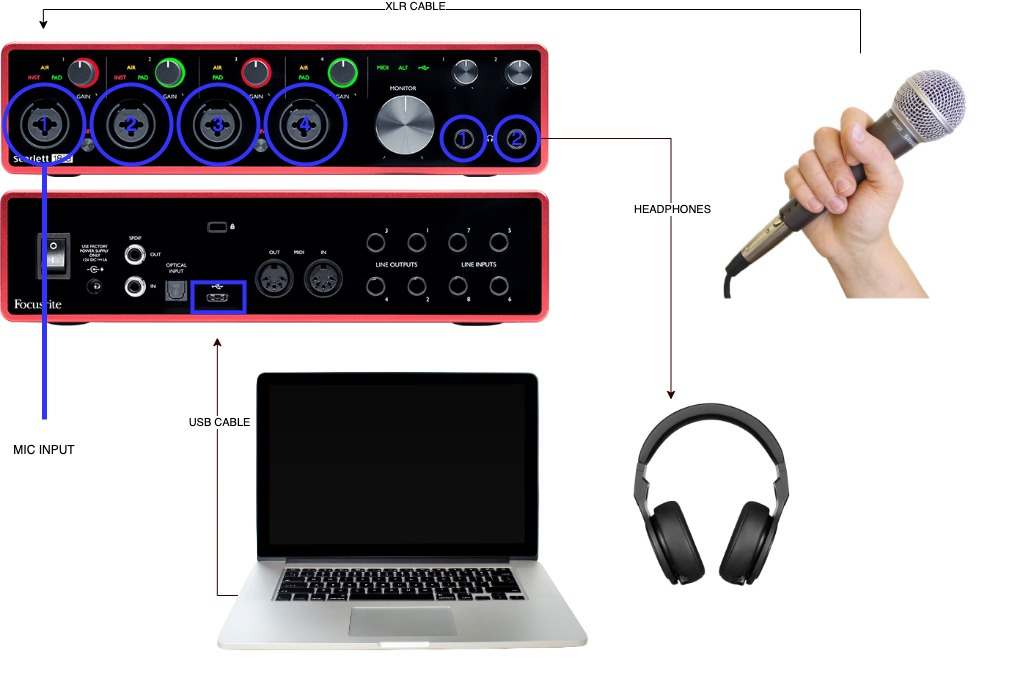THE BASICS: WHAT IS AN AUDIO INTERFACE?
An audio interface simply converts the analogue signal into a digital signal that your computer can understand and process. A non-USB microphone has a so-called XLR (External Line Return) connection and can’t be plugged straight into a computer.
For you to be able to connect an XLR microphone to a computer, you will need an audio interface, sometimes known as a sound card or an ADDA (Analog to Digital Recording, Digital to Analog Playback) converter. These audio interfaces usually have at least one or more XLR input connections built into them. They are used to get an analogue signal from a microphone or a musical instrument into the audio interface. Then, the audio gets amplified, and it will pass through an analog-to-digital converter, which is built into the soundcard itself. After that, the audio travels via a USB cable from the audio interface to the computer.
To illustrate this concept better, here is a diagram that explains everything from a visual point of view.

WHAT IS A USB MICROPHONE?
A USB microphone is an all-in-one device that incorporates all the abovementioned components into a more portable package. This type of microphone might be particularly useful while travelling, but it can be pretty limited in more professional applications. In simple terms, a USB microphone is an XLR microphone with an audio interface incorporated into each other. It definitely looks like a microphone, but inside, it has more components than a simple XLR microphone. Many times you will find a headphone jack and a volume knob on the body of the microphone. This will turn it not just into a recording audio interface AD converter but also into a playback audio interface DA converter.
Here is also where the confusion relies on such devices! Many people don’t understand that this type of microphone is meant to bypass your internal audio interface from your computer/laptop. Often, inexperienced podcasters will plug in their headphones using the headphone output port from their computer. This leads to a lot of problems while recording, such as sample rate sync issues, audio interface priority issues, and more.
LIMITATIONS OF A USB MICROPHONE.
The main limitation of a USB microphone is that it is not expandable. This means that a USB Mic can not be linked with another USB Mic, nor it can be used with another one on the same computer at the same time. This implies huge limitations since, as a podcaster, you might at some point interview a guest in person or maybe get a co-host on your show.
ADVANTAGES OF A USB MICROPHONE.
One advantage of using a USB Microphone is that it is extremely portable. It can easily fit in a small bag, and you can start podcasting within minutes.
LIMITATIONS OF AN AUDIO INTERFACE.
One drawback of an audio interface is that it can seem a bit intimidating at first. It is also a bit more complicated to set up and it involves additional cables for it to work. You will most definitely need an XLR cable for the mic and a USB cable which, depending on your application it can be of one of these configurations, B-A, B-C, C-C. Most of the audio interfaces are powered via USB, so you will not need an additional cable to power it up. However, more complex audio interfaces will include a power supply as well.
ADVANTAGES OF AN AUDIO INTERFACE.
On the other hand, a standard audio interface would accept at least two microphone inputs. This will allow you to record two microphones on two distinct channels at the same time. Other models have four inputs or even 10 inputs so it’s really your choice what you want to pick. A standard audio interface will have at least 1 headphone port, but if you want, you can easily purchase one with two headphone ports instead. Another great advantage of using an audio interface is the quality of the recording; sound cards don’t need to be compact, so better converters are used instead, allowing for a more pristine sound. Another great selling point of this type of system is that XLR mics are always of better quality because they are most of the time aimed for professional use.
Conclusion and what I recommend!
For any serious application, a sound card will always be a more practical approach. It will produce a better sound, and you will always have a lot of versatility when using it. In the next article, I will share with you which audio interface would be the best option for your setup, how to make a choice, and how not to spend a lot of cash on one.
Bogdan Bratis
CEO & Founder of Saspod. Podcast Producer & Digital Marketing Expert. I'm based in Glasgow, where on the side I play keyboard in function bands throughout Scotland, and I'm addicted to coffee.


Comments
No comments yet!